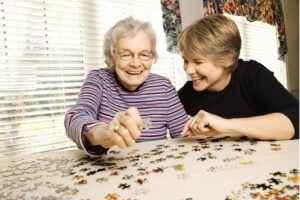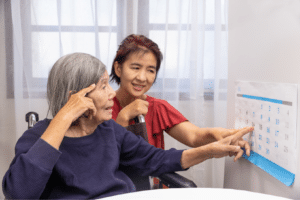What does the world look like when you’ve never seen it? How do you express what’s inside of you when you can’t see what’s outside? How do you capture emotions on paper when you can’t remember what colors look like?
For most of us, even trying to think of answers to these questions would be daunting. For Mary Seymour, they’re just another challenge, and another opportunity to express herself, discover new opportunities, and learn more about this world.
At 93 years old, and blind since childhood, Mary has decided to take up painting at Institute on Aging, because she knows that no matter how old you are, life is a constant exploration. With the help of the staff, Mary has invented a new way to craft art, to explore her memory, to express her emotions, and to make something beautiful for the rest of the world. She’s a living, vibrant tribute to the spirit of humanity, to the universality of art, and to the idea that aging comes in whatever way we want it to.
A World Never Darkened by Challenge
Mary was born with sight, but became visually impaired early in her childhood. Still, she didn’t know she was blind until she was twelve, not until then realizing she was different from her other family members.
She remembers running after her brothers in the farm fields of Louisiana where, before widespread electricity, the nights were dark for everyone. She followed their footsteps through the fields, not knowing that the way she saw the world was any different than the way they did. She learned very early on the power of never accepting a difficulty as insurmountable.
Now, some 90 years later in San Francisco, Mary still has the spirit of that little girl determined to run through unseen lands. As Kelly Harris, the ADHC Manager at IOA explains, her only real difficulty is that she sometimes gets bored. Mary’s always asking, “What are we going to do today? What are the plans? Any entertainers coming in?” She’s always looking for the next new thing, the kind of spirit we adore.
So one day, with encouragement from Kelly, she decided to take up painting. Mary had never painted before, but she does have an artistic background. And, more than that, she has a life full of experience she was eager to translate onto paper and canvas. The staff at IOA shared with her the importance of art therapy, and gave her the confidence she needed to get started. Basically, as Kelly explained, “We took the rules away. We let her create her own road map.”
The Therapeutic Nature of Art
For Mary, like for so many others, art therapy has become a vital part of aging. There are many benefits, including:
- Expressing yourself: Too often in our society, there’s an unspoken and cruel agreement that when you are older, you have to shut down your personality, and acquiesce to life. You aren’t given forums to express who you are. But art therapy helps create that venue.
- Stress relief: Fear of sickness, of finances, and just the stress that comes with getting older can be extremely challenging. Having something else to focus on, something almost meditative, can help that stress melt away.
- Exercising mental muscles: Art exercises both halves of the brain. It’s creativity and it’s also problem-solving. How do I make this paintbrush match the vision in my head? How do I finish this sculpture? It’s a workout for the brain, which improves mental health.
- A sense of purpose: Having something to create gives a person a sense of purpose, a drive, and a mission. That’s extremely important for people who feel their worlds have been circumscribed. Art therapy is a way to open the world back up.
For Mary, creation meant many of these things, but it also meant a chance to explore her memory, and bring the past back to life.
Outside the Lines and Inside Yourself
Mary started her art journey focused on patterns. She wears very interestingly patterned clothing, and Kelly wanted to try to recreate her unique style on paper. So they took structurally-interesting objects, like shells or triangles, and did tracings on watercolor paper. Soon, these became huge patterns on oversized pieces of paper, which is when the brushes came out.
Talking about color became a means of storytelling. Mary began to share what “red” means to her, or how she imagines “blue” as the cool feeling on her skin. She talked about her emotions, what she was feeling. She talked about her childhood, and about the freedom she felt then, and feels now. Her art became a matter of aligning the colors and patterns with her stories, creating a visual representation of all she has felt and experienced, but never seen in the way that you or I do. Instead, her art became what she saw in her mind.
These beautiful, abstract pieces based on geometry and memory became a way for people to get to know her better. They became a roadmap of her life.
As the project went on, she began to bring in cassette tapes featuring music by her late husband, a jazz musician who was also visually impaired. She painted to the music, letting his sounds fill her soul and snake through her hands onto the paper. She told stories, reminiscing about her path-forging life as she created beautiful art for us to admire.
And we never cared about the lines. We never cared about the edge of the paper. We never felt that those boundaries mattered. As Mary, who never saw a darkness she couldn’t illuminate, painted her memories and her emotions, the borders didn’t matter. She would cross them all. She would break through them. She was going to make each piece of paper as full and as colorful and as beautiful as that one wild and magic canvas of her life.
Keep checking this spot for details on Mary’s upcoming art show in the new IOA Day Room this February or March!
At Institute on Aging, we work to help older adults explore life to its fullest potential. Our programs create spaces for new hobbies, new friendships, and the possibilities of the everyday. Connect with us today to learn more.







